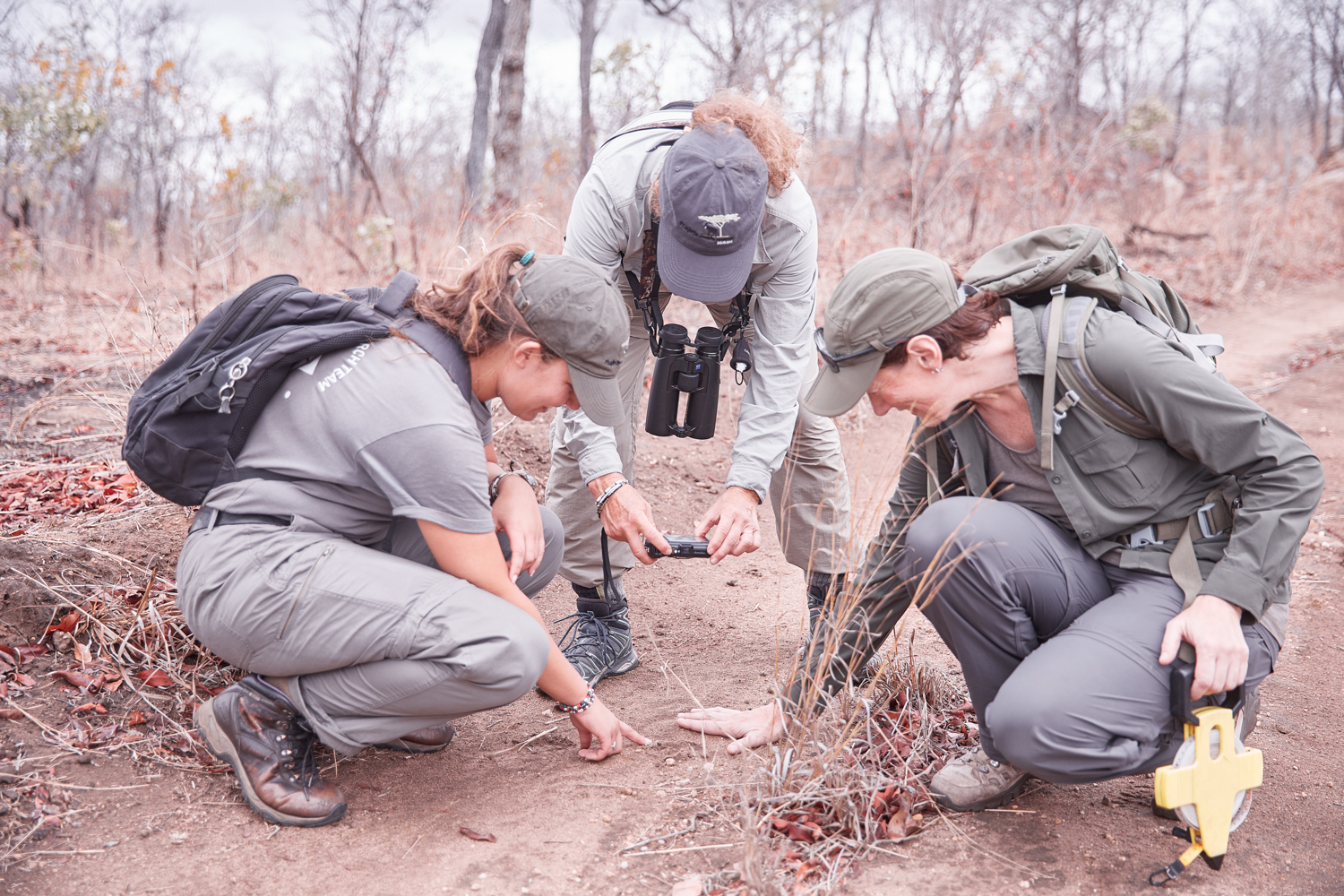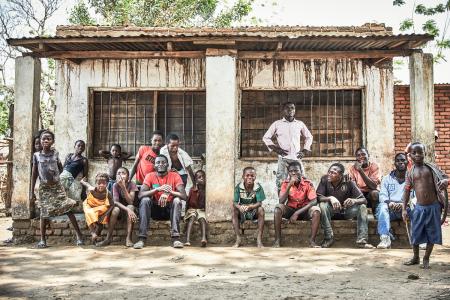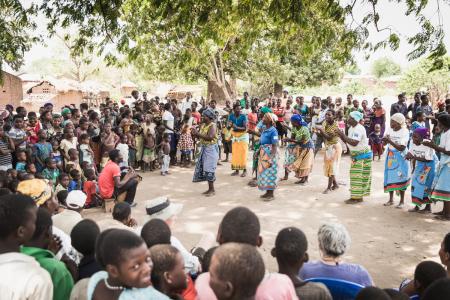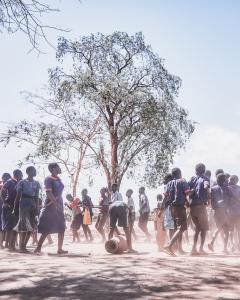Wildlife in the Warm Heart of Africa
By Nico Wills
Coming into Africa
In southernmost Malawi, bordered by the Shire River to the east and nestled into the Shire Valley, the Majete Wildlife Reserve is one of four wildlife reserves, five national parks, and over 70 protected forest reserves that lie to the west of Lake Malawi. In late October of 2017, upon landing in Malawi’s Blantyre airport, the first thing I noticed was the incredible heat. Coming from cold and wet London, the jump from 4 degrees Celsius to 44 was incredible! After speeding through immigration and baggage pickup, I found myself huddled with locals in the only shade to be found as I waited for the other members of my Earthwatch team to rendezvous for our taxi ride to the reserve.
Animals of Malawi in the Majete Wildlife Reserve. Our row of 2-by-2 meter tents stood out, green against the faded bush around them and the dried-out stream bed riddled with copious tracks from bushbuck to elephants.

Our Earthwatch team assembled, we boarded a white minivan that sped us towards Majete. Following a steep climb out of Blantyre, we could see the whole of the Shire valley spread beneath us, hazy in the afternoon sunlight and dappled with shadows from the slow-moving clouds overhead.
Hours later, tired and cooked medium-rare by the heat inside the van, we arrived at the campsite and adjoining research center we were to call our home for the next 10 days of the project
There is something incredibly special about sleeping out in the bush like this. The muted sirens, drunken chatter, aggravated car horn and occasional alarm of the city are all replaced with the incessant hum of the wildlife around you. Lying in bed, this background din was sometimes perforated by something closer, something bigger, something louder. One night I listened for what seemed like hours to the gunshot crack of snapping tree trunks as elephants casually knocked them over outside my tent to get to the green leaves up high and tasty roots below. The other thing you notice when sitting outside is the stars. Infinite pinpricks of light that seem to go on forever; so sharp and clear that it’s like seeing a whole different sky from the smattering you might be lucky enough to see above London. A truly special experience in a truly special place.
Devastation to Restoration
Majete Wildlife Reserve is an incredible story of resurgence and restoration. Just 14 years ago, the reserve was dying—an empty forest area devoid of all wildlife, save a few roaming antelope. The last rhinos had been killed in the 1970s, over 300 elephants had been poached from the area, the last one killed in 1992. The main sign of life came from locals illegally cutting down the trees for firewood and charcoal production. With this in mind, it should not be a surprise to hear that prior to 2003, almost no tourists had visited Majete and therefore hardly a single tourist dollar had been invested into the park. A handful of rangers were employed, but there was little to protect.
The Reserve faced a turning point in 2003 when African Parks, a non-profit organization, entered into a 25-year agreement with the Malawi Department of National Parks and Wildlife to manage Majete and to realize the shared vision of restoring the reserve and creating a park to tempt the tourists back into the area; most importantly, the partnership would enable wildlife to flourish. African Parks brought with it the park and infrastructure management expertise as well as a wealth of knowledge on conservation and regeneration that was needed in order to restore the park to its present success. The past 14 years have seen that dream become a reality. Starting straight away, black rhinos were introduced, elephants followed in 2006 and lions in 2012. In all, since 2003, African Parks has overseen the reintroduction of over 2,500 animals of 14 different species. Currently, total numbers of wildlife in the park are estimated at over 10,000 and it is now Malawi’s sole Big Five Destination.
But it isn’t just wildlife populations that have been positively impacted by this partnership. The park employs hundreds of local community members on a full-time basis with many more on temporary work teams. A growing ranger force patrols day and night and, as a testament to their success, not one rhino or elephant has been lost to poachers since 2003.
Majete is a wonderful example of cooperation and the possibilities that such partnerships can bring; how a park once thought dead was revived and what’s more, has flourished.


Citizen Science and Conservation
Celebrating 47 years in 2018, Earthwatch is an organization based on citizen science. This is the simple yet incredibly effective concept that one does not need to be a scientist to conduct science. The underlying factor that unites all of those who go on an Earthwatch expedition is their desire to help make a change for the better, to conserve our planet for those future generations to come. What I personally love the most about this concept is that it truly does have the ability to create change.
It has been quite some time since I first became involved with Earthwatch. Back when I was a child, two individuals encouraged my love for the natural world, both of whom were intrinsically linked with Earthwatch—Nigel Winser (late executive vice president of Earthwatch International and now Earthwatch European Ambassador) and Dr. Andrew Mitchell (co-founder of Earthwatch UK). It was while studying zoology at Edinburgh University that I was lucky enough to see first-hand the strength of Earthwatch volunteers on a project at the Cheetah Conservation Fund in Namibia, which Nigel encouraged me to visit. It created within me a passion for Africa that has never gone away.
Soon after graduating, I joined the British Army, and while I traveled extensively and operated in some incredible locations, there was little time for zoology (except often to figure out what insect was trying to make a meal of you). I left the Army after 8 years in April 2017 to pursue my passion for photography, slightly unbelieving that for once in my life, I had won a competition and that Earthwatch was giving me the opportunity to document one of their expeditions. After reading about the phenomenal successes of their translocation programs, I knew that I would love to travel back to incredible Africa and to visit Malawi and the Majete Wildlife Reserve to see the work being done there firsthand.

As the two researchers (and our field team leaders), Anel and Kayla, explained to us all as part of their opening presentation, over 95 percent of the funding for their research comes from Earthwatch; research that feeds into the staggering successes that Majete Wildlife Reserve has seen. Mainly fielded by Stellenbosch University and under the guidance of Dr. Alison Leslie, there are always at least two researchers in the camp conducting their own field studies as well as monitoring and collecting data for more legacy projects. Into this comes the Earthwatch citizen scientists.
While we were in Majete, our main role was to collect data. We spent our time driving along transects – narrow sections where we made observations and measurements, conducting vegetation surveys, running waterhole counts, and monitoring camera traps. These data help to provide a greater understanding of predator-prey ratios and wildlife numbers, as well as the effect of such populations on local fauna. It is also pure citizen science.
Data collection does not require a degree, it requires diligence, accuracy and, as comes in abundance with volunteers who sign up for an Earthwatch trip, a passion for the environment around them.



Trekking and Transects
One morning, just as the world was becoming light around us, our field team leader Kayla, two other volunteers and I clambered into a white Toyota pickup and set off for the far side of the reserve. Heads nodding, still half asleep, we watched the landscape flicker by. With clockwork precision, we stopped at a road junction just as a pair of yellow headlights appeared moving fast towards us from the other direction. Two motorbikes pulled up, and a scout with one of the largest smiles I have ever seen detached himself from the back of one bike and greeted us. Head to toe in olive green combats, rifle at his side, bush hat on his head, chest rig bearing the African Parks emblem, he would be walking with us today.
With a point from Kayla, the ranger sets off in front of us, our guide and protector in this little visited and tourist-free part of the park. Starting by the waterhole, tape measures in hand, we create four 10-by-10 meter quadrants. With each of us volunteers taking turns as scribe, we moved through each area as we observed how local animals interact with and affect local vegetation, and how this varied as we moved further away from the watering hole, recording density, coverage, dominant species, grazing damage, and height.
With each area completed, we moved deeper into the bush and, in doing so, watched our surroundings and the vegetation transform around us. Grasses waved higher, trees grew denser. The landscape also mutated, and hours from our original transect location, we were holding onto trunks and scrubs as we descended steep banks into old dried out river beds, the vegetation thick and overhanging before we climbed out into an area of small rolling hills, golden grasses glowing everywhere when the sun occasionally broke through the grey clouds overhead.
The joy of walking in this setting is the uninterrupted closeness to the landscape and the nature around you. Africa is often viewed through car windows and safari vehicles. Walking in this ancient ecosystem gives you an incredible perspective that cannot be emulated by any vehicle-born tour. Most obvious are the sounds around you that an engine drowns out. The sighing of the wind as it moves through the grass, the calls of insect, bird, and beast. At one point, the thunderous trumpeting of an elephant bounced from hill to hill nearby, the primeval part of your brain raises hairs on your neck and causes your heart to beat quicker as adrenaline is injected into your bloodstream. As you continue to move through the transect, the sharp bark of baboons on sentry warn of your presence as you venture into their territory.
Final transect completed, the ranger guides us onto an old dirt track that he says will lead us back to our vehicle and the waterhole start point. No longer walking cross-country and having to watch our footfalls, all heads are up taking in the beautiful landscape. Along our way, we stop to watch the slow progress of a tiny leopard tortoise as it crosses the road in front of us. Further on, we pause again at fresh hyena tracks. Amiable conversation and good spirits see our boots eat up the distance to the truck. As we arrive back, the ranger pauses, hand up to signal us to do likewise. “Look” is all he says. Smile wide, his hand reaches out towards the water hole, guiding our eyes to the elephants now inhabiting it. Like grey ghosts, their huge bodies seem to fade in and out of focus as they blend with the land around them as they come to drink their fill. The originators of that earlier echoing call found, we climb aboard our ride. Seconds turn to minutes as we gaze out at the family group less than 50 meters away. Eventually, they move off, becoming invisible again in the bush. The engine turns on, breaking us from our reverie and we start off towards the camp and home.
A Fond Farewell
Our time in Majete was incredibly special in more ways than one. We took part in research important to the future preservation of the wildlife in the reserve. Hand in hand with this, we spent time with employees of African Parks and with local villagers and children. It was fascinating to see how Earthwatch and its volunteers have a direct, positive effect on the research being conducted in the park. That research helps benefit the local flora and fauna, as well as local education and community projects, sharing how to live sustainably and successfully with the park, which in turn helps the park to flourish. A generation of young Malawians are growing up with this knowledge taught to them from the offset. It truly is an incredible project.
As I sit writing this, now back home in London with the cold rain hammering against the windows, I can only look back on my time spent in Malawi with happy memories. To Earthwatch and African Parks: Thank you for offering me this opportunity to join the research team in Majete and for an incredible 10-day experience. And to my fellow volunteers: Thank you for putting up with me and my camera and hogging the precious power to charge batteries. To the locals of Majete: I have never felt more welcome nor more humbled by the generosity of people who, having so little, gave us all so much. You are inspirational and I cannot help but feel that if more of the world were like you, then a better world it would be.
Join an Earthwatch expedition and help researchers gather the data they need to best manage the park and make sure all its species thrive.
If you have any comments or questions related to this story, please contact us at communications@earthwatch.org. We welcome your feedback.
Sign up for the Earthwatch Newsletter
Be the first to know about new expeditions, stories from the field, and exciting Earthwatch news.




